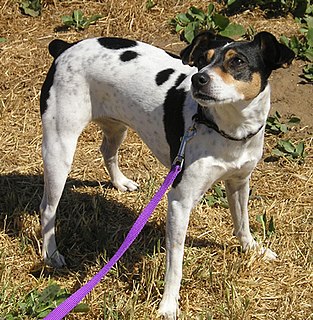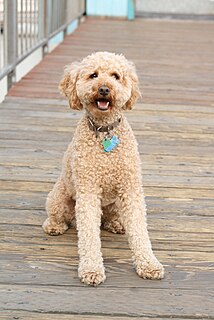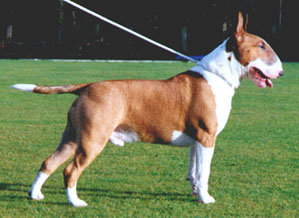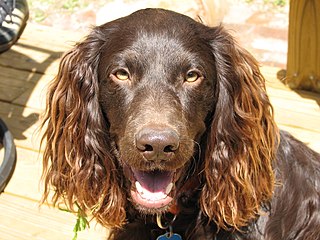
The American Kennel Club (AKC) is a registry of purebred dog pedigrees in the United States. In addition to maintaining its pedigree registry, this kennel club also promotes and sanctions events for purebred dogs, including the Westminster Kennel Club Dog Show, an annual event which predates the official forming of the AKC, the National Dog Show and the AKC National Championship sponsored by Royal Canin, formerly the AKC/Eukanuba National Championship. Unlike most other countries' kennels clubs, the AKC is not part of the Fédération Cynologique Internationale.

The American Eskimo Dog is a breed of companion dog, originating in Germany. The American Eskimo is a member of the Spitz family. The breed's progenitors were German Spitz, but due to anti-German sentiment during the First World War, it was renamed "American Eskimo Dog". Although modern American Eskimos have been exported as German Spitz Gross, the breeds have diverged and the standards are significantly different. In addition to serving as a watchdog and companion, the American Eskimo Dog also achieved a high degree of popularity in the United States in the 1930s and 1940s as a circus performer.

The Staffordshire Bull Terrier is a breed of short-haired, medium-sized dog that was developed in Staffordshire, England and northern parts of Birmingham. The breed originated by crossing the Bulldog and Black and Tan Terrier, and evolved over time with the infusion of other breeds for refinement of purpose which, in Victorian England prior to the banning of blood sports in 1835, was ratting, bull-baiting, and dog fighting, the latter of which continued as a clandestine sport.

The Yorkshire Terrier is a small dog breed of terrier type, developed during the 19th century in Yorkshire, England. Ideally its maximum size is 7 pounds (3.2 kg). A popular companion dog, the Yorkshire Terrier has also been part of the development of other breeds, such as the Silky Terrier. It has a grey, black and tan coat, and the breed's nickname is Yorkie.

Dog breeding is the practice of mating selected dogs with the intent to maintain or produce specific qualities and characteristics. When dogs reproduce without such human intervention, their offspring's characteristics are determined by natural selection, while "dog breeding" refers specifically to the artificial selection of dogs, in which dogs are intentionally bred by their owners. Breeding relies on the science of genetics, so the breeder with a knowledge of canine genetics, health, and the intended use for the dogs attempts to breed suitable dogs.

Poodles are a group of formal dog breeds, the Standard Poodle, Miniature Poodle and Toy Poodle. The origin of the breed is still discussed, with a prominent dispute over whether the poodle descends from Germany as a type of water dog, or from the French Barbet.

The Rat Terrier is an American dog breed with a background as a farm dog and hunting companion. Traditionally more of a type than a breed, they share much ancestry with the small hunting dogs known as feists. Common throughout family farms in the 1920s and 1930s, they are now recognized by the United and American Kennel Clubs and are considered a rare breed. Today's Rat Terrier is an intelligent and active small dog that is kept both for pest control and as a family pet.
Toy dog traditionally refers to a very small dog or a grouping of small and very small breeds of dog. A toy dog may be of any of various dog types. Types of dogs referred to as toy dogs may include Spaniels, Pinschers and Terriers that have been bred down in size. Not all toy dogs are lapdogs, although that is an important and ancient type of toy dog.

The French Bulldog is a breed of domestic dog. In the 1800s, they were the result of a cross between Toy Bulldogs imported from England and local ratters in Paris, France.

Crossbreed dogs, sometimes called designer dogs, are dogs which have been intentionally bred from two or more recognized dog breeds. They are not dogs with no purebred ancestors, but have not been selectively bred enough to breed true and be recognized as a breed in their own right.

A companion dog is a dog that does not work, providing only companionship as a pet, rather than usefulness by doing specific tasks. Many of the toy dog breeds are used only for the pleasure of their company, not as workers. Any dog can be a companion dog, and many working types such as retrievers are enjoyed primarily for their friendly nature as a family pet, as are mixed breed dogs. The American Kennel Club also offers a Companion dog title for judged dog obedience competitions.

Poodle crossbreeds or poodle hybrids are the offspring of purebred poodles that have been crossbred with another purebred dog breed. They may be described as a mixed breed dog, designer dog Mutt/Mongrel, sometimes, as a hybrid dog.

The Glen of Imaal Terrier is a breed of dog of the terrier category and one of four Irish terrier breeds. It is sometimes called the Irish Glen of Imaal Terrier or the Wicklow Terrier, and the name of the breed is often shortened by fanciers to just Glen.

The Bull Terrier is a breed of dog in the terrier family. There is also a miniature version of this breed which is officially known as the Miniature Bull Terrier.

The Boykin Spaniel is a medium-sized breed of dog, a Spaniel bred for hunting wild turkeys and ducks in the Wateree River Swamp of South Carolina, in the United States. It is the state dog of South Carolina, where it was discovered and further developed by hunters in the 1900s. 1 September is Boykin Spaniel Day in South Carolina.
The National Rat Terrier Association (NRTA) is an American breed-specific registry for Rat Terriers. The association provides full-service photo registries and litter registrations. Extensive breed information is available, as well as comprehensive pedigree services.

A purebred dog typically refers to a dog of a modern dog breed with a documented pedigree in a stud book and may be registered with a breed club that may also be part of a national kennel club.

The Russian Toy is a very small breed of dog originally bred in Russia from the English Toy Terrier. There are two types of coats in the breed: smooth coat and long coat. The smooth-coated variety was previously known as the Russian Toy Terrier and long-coated as the Moscow Long Haired Toy Terrier. Both were brought together under the same Russian Toy Terrier name in 1988 and the "Terrier" was dropped from the name when the breed was added in 2006 to the official list of breeds registered with the Fédération Cynologique Internationale and has been registered in the Foundation Stock Service of the American Kennel Club since 2008, allowed to compete in AKC companion events since 2010. The first official breed standard of the two varieties was written in 1966 in Russia.

Pedigree Dogs Exposed is a BBC One investigative documentary, produced by Jemima Harrison, which looks into health and welfare issues facing pedigree dogs in the United Kingdom. It was originally broadcast on 19 August 2008.
Pedigree Dogs Exposed: Three Years On is a 2012 follow-up to the 2008 BBC One documentary, Pedigree Dogs Exposed (PDE). While this second programme looks at the positive changes made since the original film, it focuses on investigating areas of continuing concern. The programme concluded that it was time to call a halt to suffering created by breeders. It states that as long as The Kennel Club (KC) tolerated human whim leading to dogs that cannot run, breathe, or see freely, dogs would continue to suffer, but featured that, in fact, KC would continue in the vein, suggesting that the organisation has a conflict of interest in juggling its commitments to breeders and to dogs – when the interest of dogs does not match up with that of breeders, the dogs suffer. It also called on dog fanciers to stop being consumers of 'freak-show" appearance, the driving factor in developing dogs to physical extremes. KC refused to participate in the production. The programme aired on 27 February 2012 in the United Kingdom.





















